15 Items Found in King Tut's Tomb
In 1923, in the middle of the winter digging season, Egyptologist Howard Carter discovered the main tomb of King Tutankhamun, the teen-aged ruler of Egypt who died in 1323 B.C.E. King Tut, as he became known, ruled for only six years and was probably about 19 when he died.
In 1907, Theodore M. Davis was excavating at site KV54, the tomb of Horemheb. He found a small chamber in which he found some funerary items with the name of Tutankhamun. Davis assumed those items were all that remained of the boy king and ended the dig. King Tut’s possible remains became a mere footnote. Davis concluded in a 1912 publication that he considered the archaeological possibilities of the Valley of the Kings to be exhausted.
In 1922, however, one of the most important finds in the Valley was stumbled upon by Carter. He was directing the excavation of site KV62 (Kings’ Valley site 62) when he excavated under a line of workers’ huts which had been abandoned earlier. Under the huts, a series of steps carved into the bedrock were discovered.
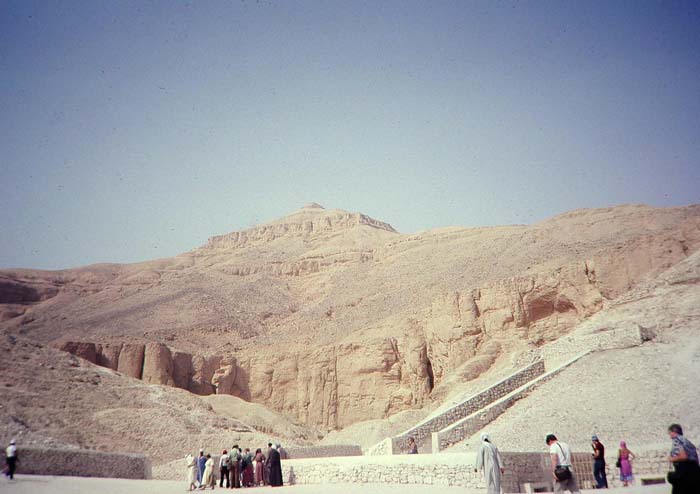
© Jimmy Smith - Entrance to the Tomb of Tutankhamun
The steps led down to a plastered doorway marked with cartouches, or oval seals, engraved with the name of King Tut. While the discovery was exciting prompting the sponsor of the dig, British Lord Carnarvon and his daughter to arrive at the site some weeks later, the major discoveries were found by happy accident.
Grave robbers had apparently twice invaded the inner tomb of King Tut. After their depredations ended, the thieves had clumsily resealed the passage leading the real treasures buried with the boy king with chips of limestone. At the end of this corridor, a second door was discovered on November 4, 1922. On November 29, the tomb was opened.
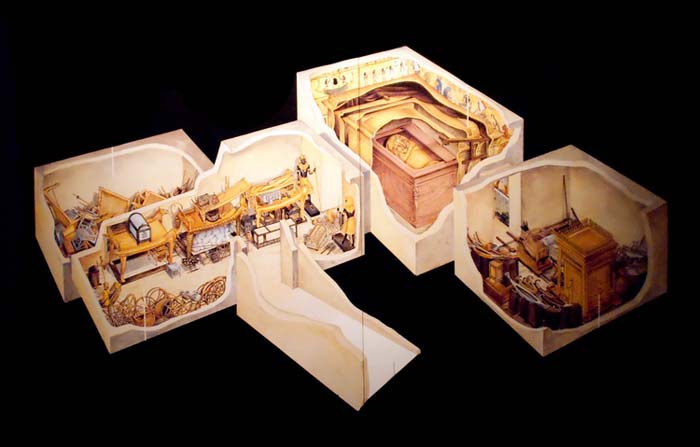
© Zsolt Andrasi - Rooms within Tutankhamun's Tomb
As Howard Carter later wrote, ‘At first I could see nothing, the hot air escaping from the chamber causing the candle flame to flicker, but presently, as my eyes grew accustomed to the light, details of the room within emerged slowly from the mist, strange animals, statues, and gold - everywhere the glint of gold.’
Howard Carter was a painstaking researcher and an excellent cataloger, spending 10 years at the task. The items in the inner chambers had been protected from robbery by pure chance. The array of priceless antiquities has fascinated amateur and professional Egyptologists since their discovery. The following 15 items from the burial chambers, removed in 1930, are the best known.
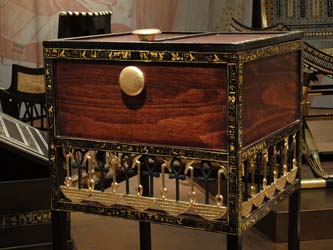
© Patty - Chest from the Tomb of Tutankhamun
1. Canopic Jars
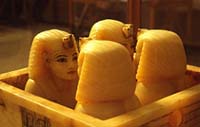
Ancient Egypt had far advanced the funeral arts. They practiced embalming methods that led the world for millennia. The body’s viscera were removed in the process of readying the body for burial and put into clay or limestone jars. It was believed that the king would require these organs in the afterlife, and so were included in his burial chamber.
2. Senet Game
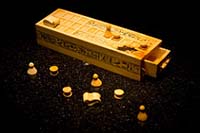
An ancient version of a board game was called Senet, or “passing”. It symbolized the passage from life to death and had been played in Egypt for about 1800 years by the time the young king died. The game was played in every stratum of society and although the rule books have long been lost, experts believe they know how the game might have been played.
3. Personal Fan
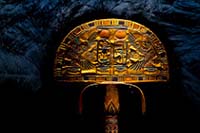
A fabulous gilded fan was included for King Tut’s exclusive use in the afterlife. This gold metal fan was inlaid with his personal royal cartouche.
4. Statue of Anubis
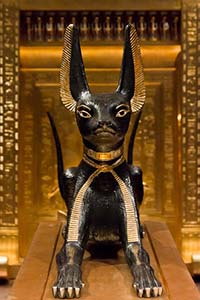
Anubis was the jackal which ushered the souls of the Egyptian dead into the underworld. Associated with the art of mummification, the canine was thought to be an effective guard for the grave.
5. Head of a Leopard
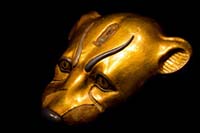
The Pharaohs long admired the strength and beauty of the African leopard and imported the animals from the South of the continent.
6. Sun Scarab Pendant
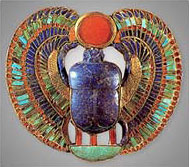
The scarabaeus sacer is a type of large dung beetle species that the ancient Egyptians worshiped as a representation of the sun god Ra. Found throughout the world, the scarab beetle rolls dung into balls and pushes them along its path. The scarab god Khepera was depicted as pushing Ra’s sun on its course westward to sunset.
The heart scarab was placed upon the heart region of the mummified corpse which it was believed to have been weighed against that of a feather of truth for admittance to the afterlife.
7. Burial Mask
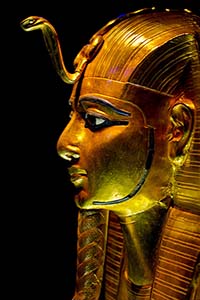
This golden mask represents King Tut as a physical ideal. The beard on the mask was said to have been damaged and separated, then hastily glued together with epoxy. The Egyptians deny the evidence, but the telltale line is there for all to see.
The beard represented was the standard for all rulers, both male and female. The beards were ceremonial and stylized, being worn as a garment rather than grown naturally.
8. Throwing Sticks
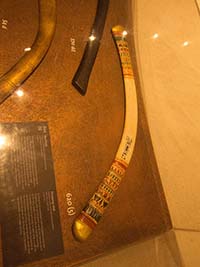
Throwing sticks are bird-hunting weapons, rather like the Australian aboriginal boomerangs. A popular sport for Egyptian royals, these sticks were included in the chamber so that the king could hunt birds in the afterlife as well.
9. Statue of Ptah
The god Ptah was a god of creation, the patron of architects and craftsmen, those who built the tomb and everything it contains. The god is known as the ‘beautiful face’, the lord of eternity’, and the ‘master of justice’.
10. The Royal Chariot
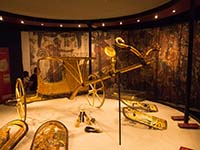
The personal chariot of King Tut was disassembled after his death and placed within his tomb. After its discovery, it was reassembled and is on display in the Egyptian Museum located in Cairo. Although some believe the king was killed in a fall from the vehicle, most experts think he died of disease or other accident.
11. Perfume Vessels
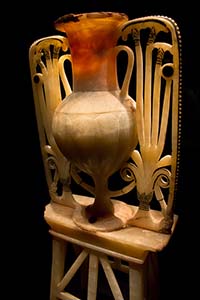
These alabaster containers were filled with rare and expensive unguents for his use in the afterlife. The interiors of some of the vessels are still marked with the fingerprints of the ancient grave robbers. The exteriors are inscribed with the visage of the fertility god Hapti who was responsible for the essential annual Nile River floods.
12. Personal Necessities
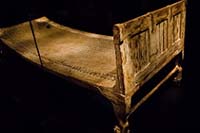
Everything the young king could keep in a jewel box was included in the crypt. Anklets, buckles, bracelets, pectoral decorations, necklaces, collars, ear studs, earrings, all were included for his adornment in the afterlife. To get around in the hereafter, the contents of the tomb included six chariots, two thrones, couches and ritual beds complete with stone headrests.
13. Painting of Warfare
Showing King Tut as he receives the severed heads of his enemies, the painted wood panel shows him aiming at his enemies, possibly Syrian, with his drawn crossbow.
14. Representation of King Tut as a Child
This representation of the king’s childhood visage is unusual. The Pharaonic tradition dictated that the Pharaoh wed their brother or sister. Because of this interbreeding, the skulls of the Pharaohs were shaped unusually and the result can be seen in this image.
15. The Mummified Body of King Tut
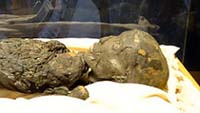
Of course, the final and by far the most important thing contained in the tomb is the king himself. The body has been analyzed by medical experts and their conclusion was that he was small and most likely ill. He had a club foot and suffered from malaria. He was father to two stillborn girls by his half-sister.
There have long been stories about the curse supposedly activated when the tomb was opened. Many coincidental deaths and injuries happened in rather close order at about the same time as the excavation, and the cataloging and removal of items from the crypt. All the deaths, while unusual in their proximity, have perfectly natural explanations.
